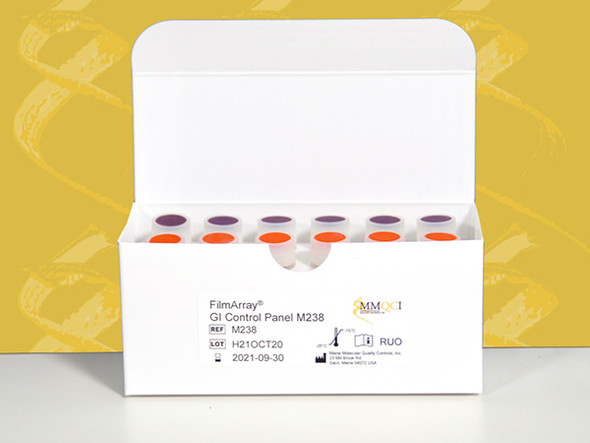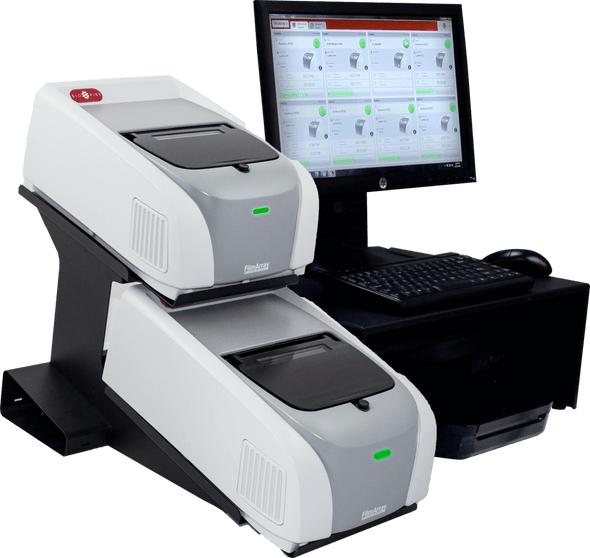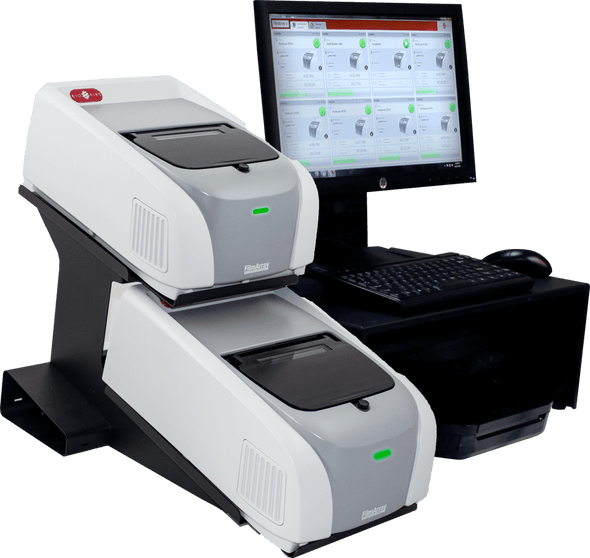Description
MMQCI FilmArray® Ebola Control Panel M251
Part Number: M251
Kit Contains: 12 tubes x 200 µL
6 each of M25218 & M25318
FilmArray® Ebola Control Panel M251 DataSheet
INTENDED USE:
The FilmArray® Ebola Control Panel M251 is intended for in vitro use as a quality control to monitor the presumptive detection of Ebola Zaire virus in whole blood specimens when tested by the FilmArray® BioThreat-E test on the FilmArray® instrument.
The FilmArray BioThreat-E test is performed on the FilmArray instrument to detect RNA from the Ebola Zaire virus in specimens from individuals with signs and symptoms of Ebola virus infection in conjunction with epidemiological risk factors. Ebola virus disease (EVD), formerly known as the Ebola Hemorrhagic Fever (EHF), is a disease in humans caused by four of five viruses in the genus Ebolavirus, from the family Filoviridae. The four viruses are Bundibugyo virus (BDBV), Sudan virus (SUDV), Taï Forest virus (TAFV), and Ebola virus (EBOV, also known as Zaire Ebola virus). The Ebola Zaire virus is the most dangerous of the known EVD- causing viruses and is responsible for the 2014 West Africa Ebola virus outbreak, with the largest number of deaths to date1. As of October 25, 2014, the World Health Organization has reported there are 10,141 confirmed, suspected, and probable cases of EVD in six affected countries (Guinea, Liberia, Mali, Sierra Leone, Spain, and the United States of America) with 4,922 reported deaths.2
FilmArray® Ebola Control Panel M251 cannot be cloned, sold, or transferred without the explicit written consent of MMQCI.
PRODUCT SUMMARY and PRINCIPLE:
FilmArray® Ebola Control Panel M251 is comprised of synthetic DNA suspended in a non-infectious solution of buffers, preservatives and stabilizers.
Best practice is to establish a quality control program for every assay performed by the laboratory.3, 4 Routine use of quality controls that are consistent lot to lot assists the laboratory in identifying shifts, trends, and increased frequency of random errors caused by variations in the test system, such as failing reagents. Early investigation can prevent failed assay runs.
STORAGE and STABILITY:
FilmArray® Ebola Control Panel M251 should be stored at 2 - 8°C. Unopened FilmArray® Ebola Control Panel M251 is stable through the expiration date printed on the kit label when stored refrigerated (2° – 8°C). FilmArray® Ebola Positive Control and FilmArray® Ebola Negative Control are for single use. Discard after use according to your local and federal regulations.
PRECAUTIONS and WARNINGS:
- Do not
- This product is intended for in vitro analytical testing and is provided for Research Use Only, not for use in diagnostic
- This product does not contain any biological material of human
- This product does not contain any live or attenuated
- FilmArray® Ebola Control Panel M251 has not been validated for preparation as a urine sample.
COMPOSITION:
The FilmArray® Ebola Control Panel M251 is comprised of 12 single use tubes, 200µL each, of synthetic DNA suspended in a non- infectious solution of buffers, preservatives and stabilizers. There are
6 tubes of FilmArray® Ebola Positive Control and 6 tubes of FilmArray® Ebola Negative Control.
INSTRUCTIONS FOR USE:
- FilmArray® Ebola Control Panel M251 should be processed as a whole blood Follow BioFire Defense’s instructions in the Prepare Sample Mix – WHOLE BLOOD section of the FilmArray® BioThreat-E Instructions for Use.
- Allow the control to be tested to come to room temperature (18° – 25°C).
- Use the control as DO NOT DILUTE.
- Prepare and hydrate a pouch according to FilmArray®
- Immediately before use, mix the control by briefly vortexing the tube for 3 – 5 seconds and then shake the tube down firmly to remove any droplets caught in the
- Aspirate the control using the FilmArray® transfer
- Analyze the control as you would a patient sample by adding the control to the FilmArray® Sample Injection vial containing the buffer/protease mixture prepared according to manufacturer
- Discard after use according to your local and federal
EXPECTED VALUES:
Table 1: FilmArray® Result Summary Interpretation
|
Virus |
M25218 Call |
M25318 Call |
|
Ebola Zaire |
Detected |
Not Detected |
The laboratory should follow Good Laboratory Practice (GLP) and establish its own performance characteristics for FilmArray® Ebola Control Panel M251 in demonstrating adequate system performance. Recoveries may vary depending on instrumentation, reagents and systematic or random errors. The expected results when the controls are analyzed are listed in Table 1.
2 Reviews
-
Amazing
The FilmArray® Ebola Control Panel M251 is intended for in vitro use as quality control to monitor the presumptive detection of Ebola Zaire virus in whole blood specimens when tested by the FilmArray® BioThreat-E test on the FilmArray® instrument The fastest delivery and the fair prices of the products amazed me so much that I am now fully satisfied with the quality and service of the Gentaur
-
FilmArray® Ebola Control Panel M251
The FilmArray Ebola Control Panel M251 is intended for in vitro use as a quality control to monitor the presumptive detection of Ebola Zaire virus in whole blood specimens when tested by the FilmArray BioThreat-E test on the FilmArray instrument. The FilmArray BioThreat-E test is performed on the FilmArray instrument to detect RNA from the Ebola Zaire virus in specimens from individuals with signs and symptoms of Ebola virus infection in conjunction with epidemiological risk factors. Ebola virus disease (EVD), formerly known as the Ebola Hemorrhagic Fever (EHF), is a disease in humans caused by four of five viruses in the genus Ebolavirus, from the family Filoviridae. The four viruses are Bundibugyo virus (BDBV), Sudan virus (SUDV), Taï Forest virus (TAFV), and Ebola virus (EBOV, also known as Zaire Ebola virus). The Ebola Zaire virus is the most dangerous of the known EVD-causing viruses and is responsible for the 2014 West Africa Ebola virus outbreak, with the largest number of deaths to date1. As of October 25, 2014, the World Health Organization has reported there are 10,141 confirmed, suspected, and probable cases of EVD in six affected countries (Guinea, Liberia, Mali, Sierra Leone, Spain, and the United States of America) with 4,922 reported deaths.2














